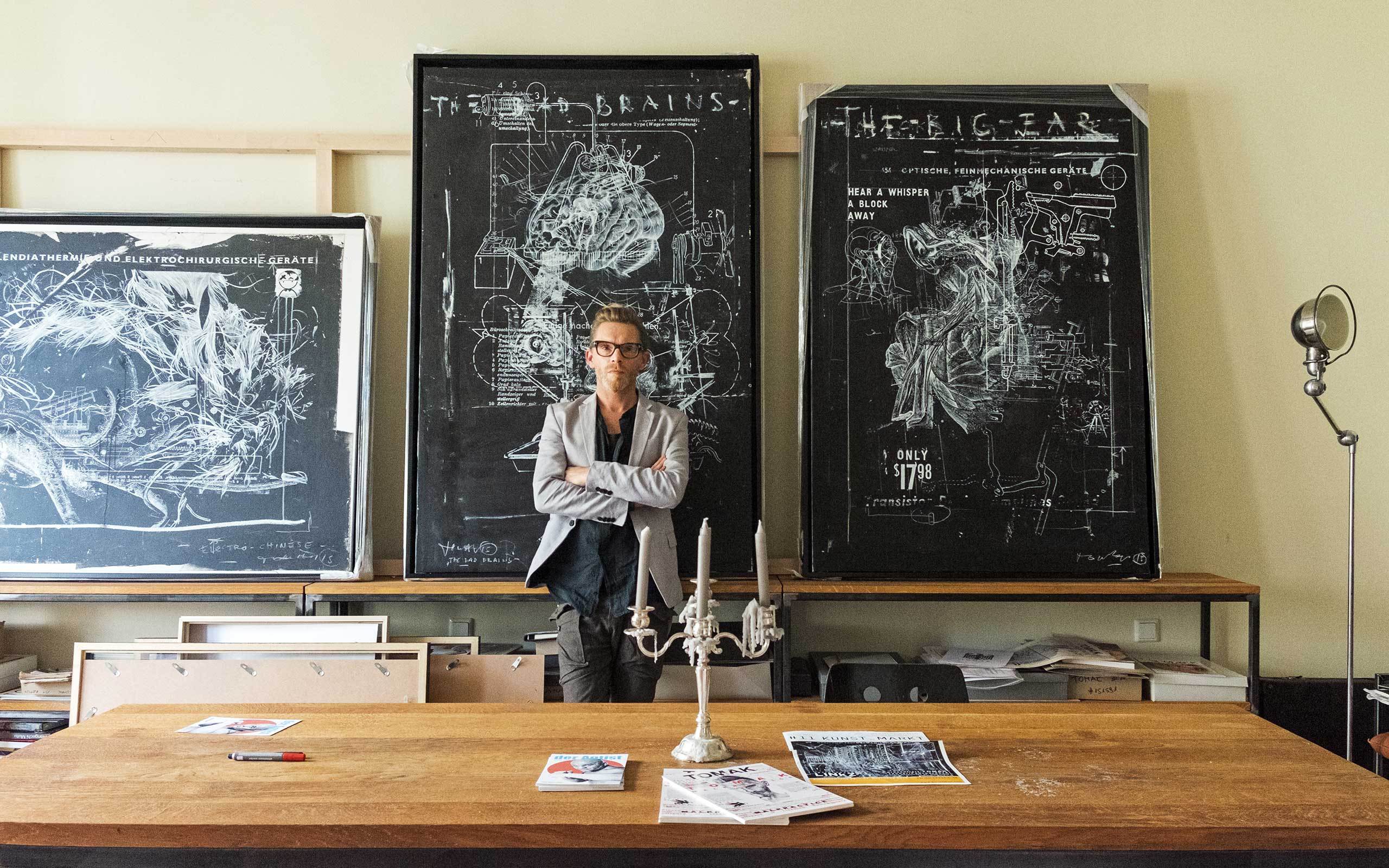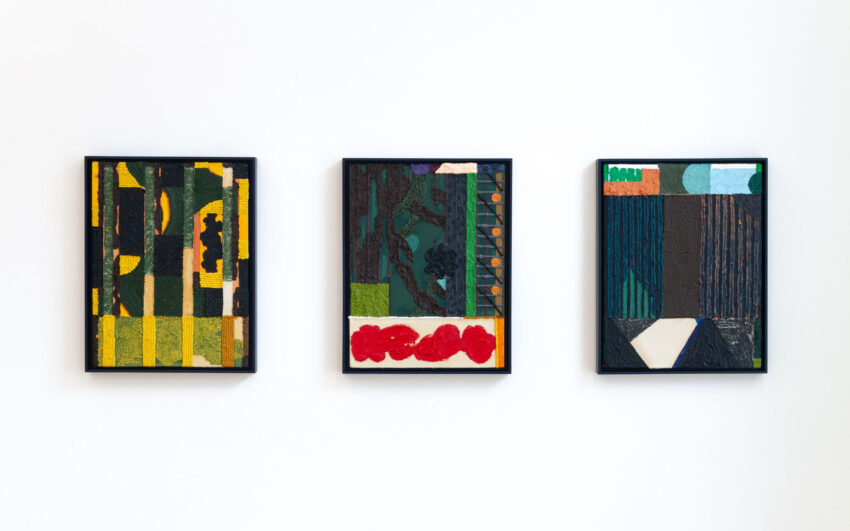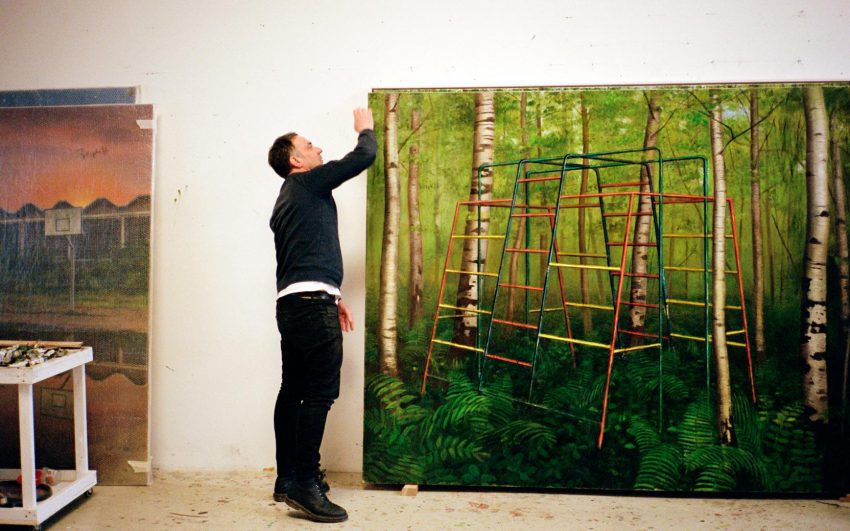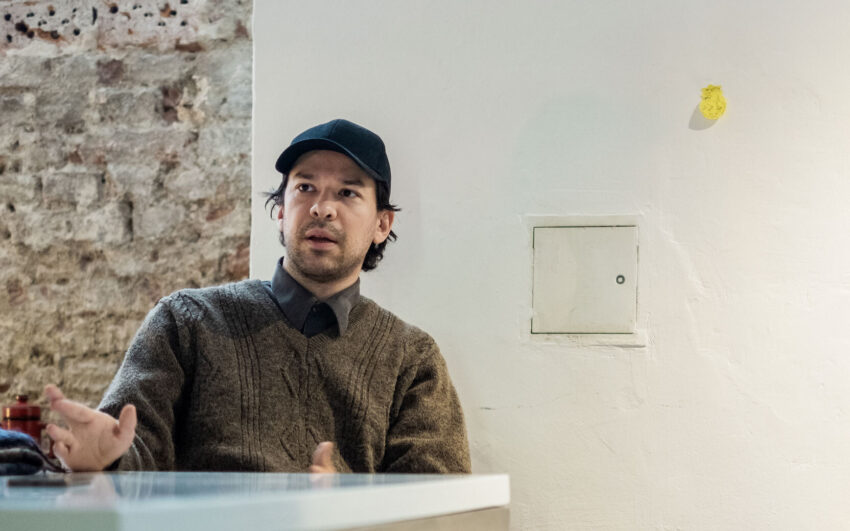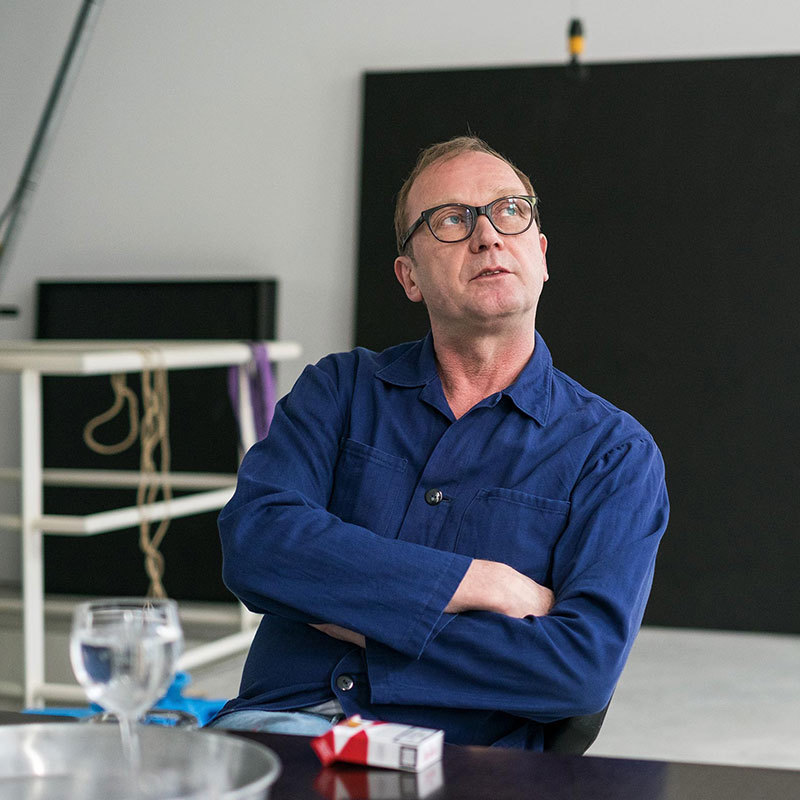TOMAK is not just an artist – he is an artistic figure, a staged persona, and a brand. He is a challenge – in five letters. A pseudonym that polarizes, provokes and insists on being listened to. We met TOMAK in his apartment at Mariahilfer Strasse in Vienna’s 6th District and talked to him about his new project, THE ANTIST, his expectations of art, and about ”painting seven minutes”.
TOMAK, all the coffee houses and bars here in Vienna have your flyer emblazoned DER ANTIST. Magazin der Wiener Avantgarde (THE ANTIST. Magazine of the Viennese Avant-garde.) What is Antist?
ANTIST is a joint project I’m doing with Lukas Pusch, a brilliant fellow artist. We both produce and publish the magazine because we love art. These days the love of art often gets lost. Once we got an art market we lost art. The first issue of ANTIST is being printed now and is ready to go to the binder’s. The magazine’s production is fairly elaborate with silk-screen printing and other refinements. It is not for nothing that we are making this magazine, it is absolutely necessary!
So you are also a publisher now with THE ANTIST. Are there only articles by you and Lukas Pusch in the magazine or also by other authors?
We feature many contributions by colleagues. Ines Doujak for example, a friend of ours, who became known through her action in MACBA in Barcelona, is writing in the first issue. There are also older articles by underground artists from Berlin and Russia, and eight pages about art by prisoners. But also texts by myself and Lukas, who is actually the magazine’s editor-in-chief. It is a good mix. Basically, I’m the person who ensures everyone stays really “sharp”. ANTISTic and not ARTISTic. For example, Lukas really wanted to print two emails I sent to my gallery owner. When you do art, you always have to explain yourself, communicate. Otherwise, how is anybody supposed to know what you are doing, what your intention is.
What does ANTIST mean?
It is a word I invented. More of an attitude. It defines an anti-attitude instead of “Be an Artist – Be an ANTIST”. Now we make this magazine from this entire pool of ideas. The first issue has been published now. There will be another issue before Christmas. The concept has long matured in our minds. It is modelled on the magnificent project by Günter Brus Die Schastrommel, in which Brus has repeatedly altered the formats. We will retain the format for now, but in future we will occasionally alter it too. In spring we will address a topic that is problematic above all in Austria “state art” or “state promoted art”, which is totally alien to the market.
The first issue has been presented in a very old boxing club, the Box-Union Favoriten, the best in Central Europe. There was a boxing-fight before the presentation. So it will really reeked of male sweat. Another connection to ANTIST. Lukas Pusch was once a boxer, too. And as we also see ANTIST as a declaration of war we think it’s a good fit.
Then in summer we will travel to Antist a village in the Pyrenees. An incredibly cool medieval village. With an inn and so on. We want to design our summer issue there. Which is why I’ve been looking at a car I’d like to buy, because if you drive to Antist you need a decent car.
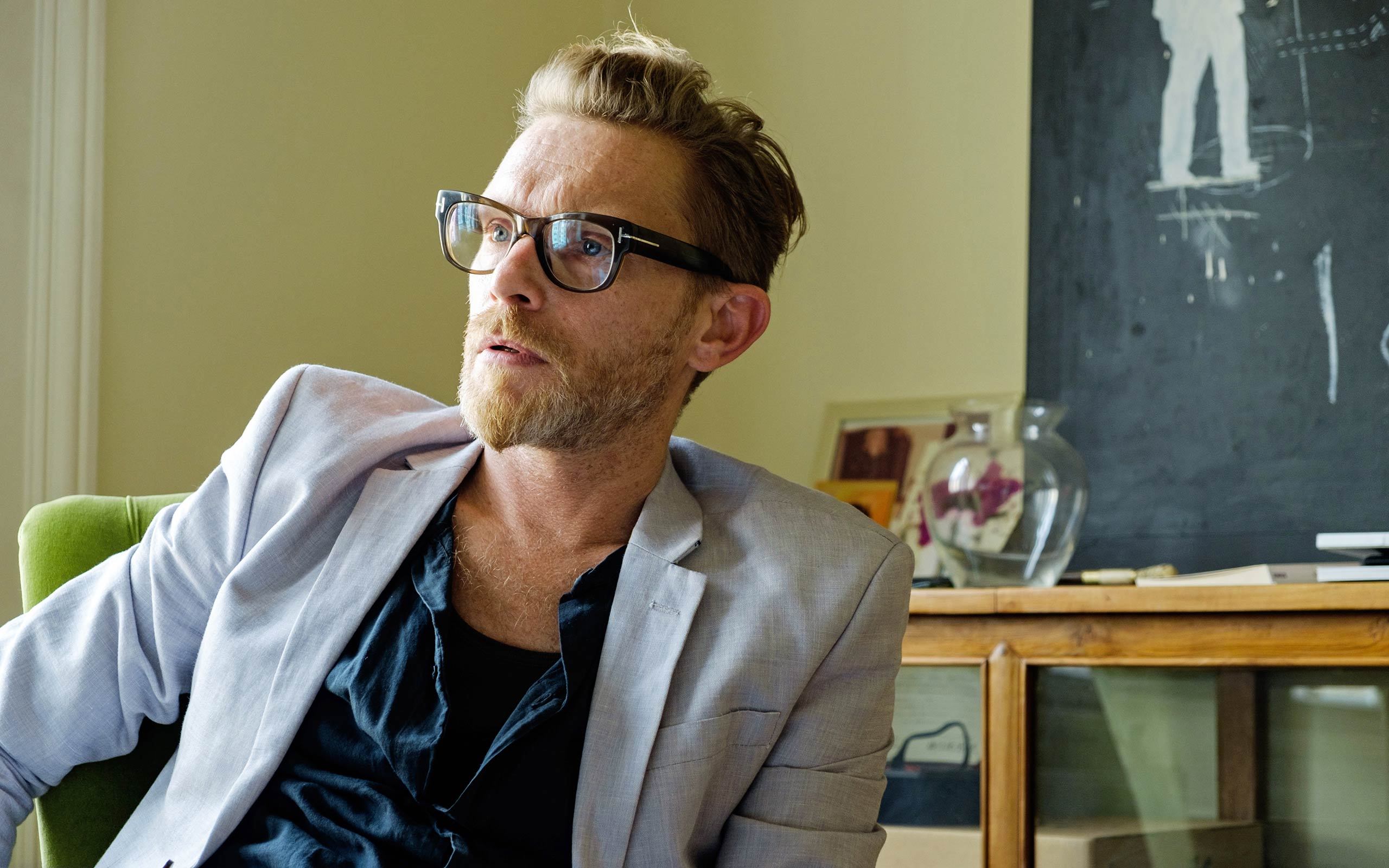
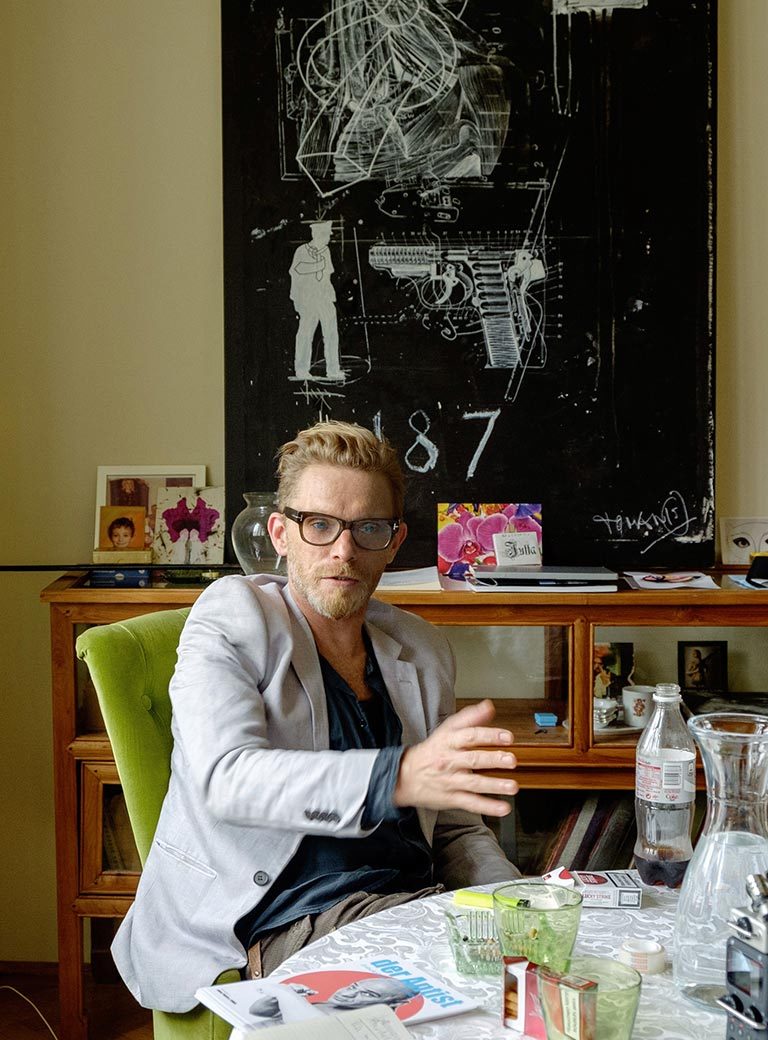
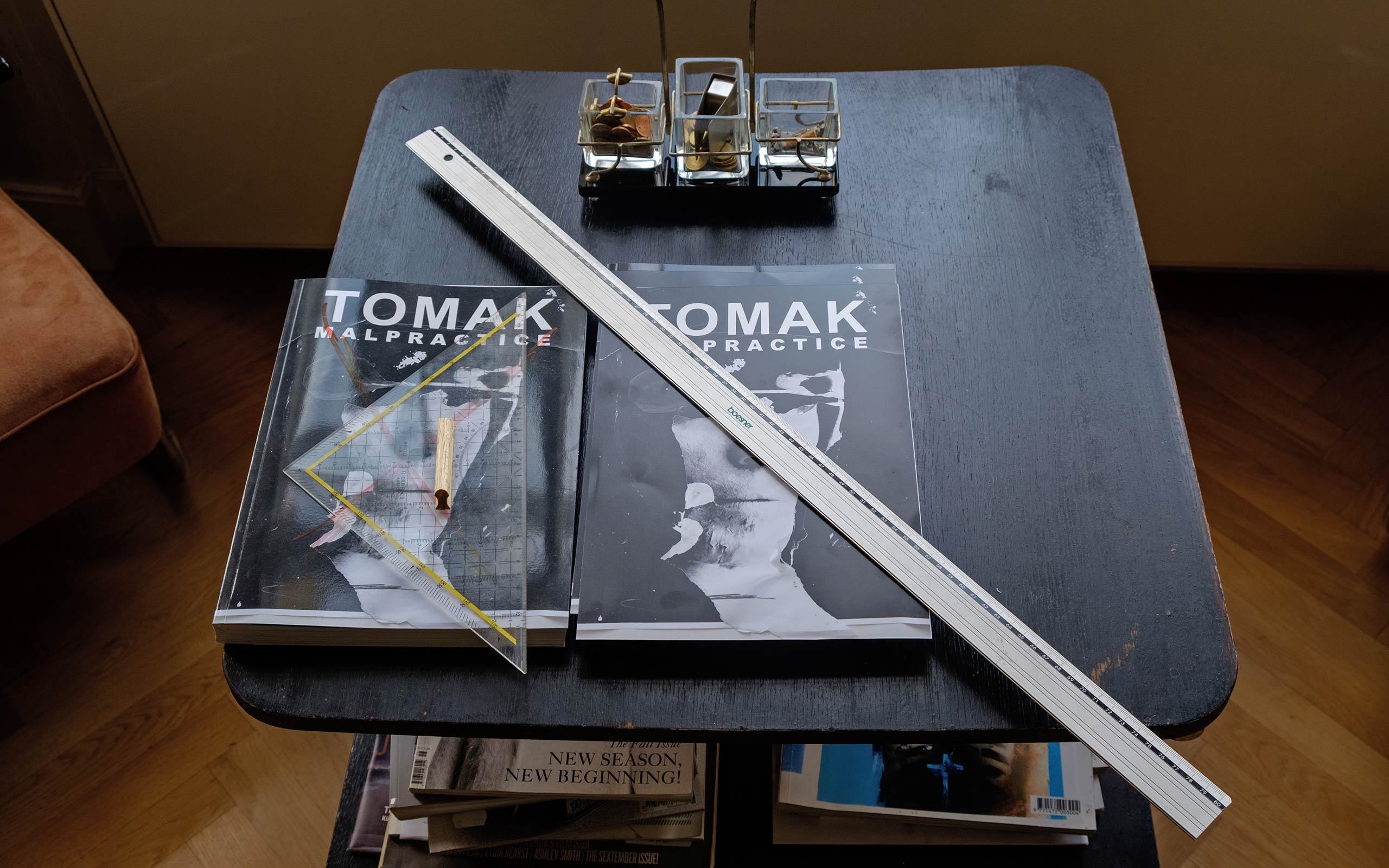
So why are you doing the ANTISTS? Why does the world need another art magazine?
Well, because it is really important. Because it is important for art. We are not making 200 copies because we imagine we’ll make money with it. We’re not interested in any money it brings. What is important is the artistic message, something that is missing today in all of Western art. It no longer exists. Everything revolves around the “art market” – hey, the word did not even exist merely 20 years ago. It is all about who is the best in some ranking list or other. When you look at the hit parade, the best are always the chart toppers like that idiot Gabalier, the crap DJ Ötzi or fucking Helene Fischer.
Now it is no longer only artists in ranking lists but increasingly also gallery owners and curators. Everything is falling apart. A true collector, not one of the nouveaux riches, does not buy in the most expensive gallery, that would be stupid. But he maybe sells it there later. The reason why some gallery owners top the ranks is because they sell to some wealthy Russian or other. But that is no longer about art, but only about value.
You are at a new gallery for some time. What expectation do you hold as an artist toward a gallery?
Yes, November 2015 I opened my show “TOMAK Malpractice” in the new 500-square-meter premises of Lisabird Contemporary in Vienna, where I presented over 70 new works of mine. We have developed an attractive concept. My gallery owner is responsible for the marketing, or rather for communicating the works to curators, collectors and museums. The most important thing is communicating the art, not marketing it. So we should talk about communicating. You have to get the right people, who might be interested in my work. Lisabird does that well. We are a good team. We have just been to Istanbul, to the fair, which was very successful.
Tell me, once you have sold a work can you still influence the way it is presented? Or does that not interest you?
Generally, the big collectors confine the works they buy into storage. I have no influence over what a collector does with a piece. But I don’t think he’s allowed to draw or paint on it. Otherwise he can do anything with it. Which is good. The best thing I’ve ever seen was a Basquiat picture, 3.50 metres wide and about 2.50 meters tall that hung on the wall behind Donatella Versace’s bed. In front a baroque bed and left and right baroque bedside tables. It looked so cool! That’s what living with art should be like! I really liked that.
I have no real objection to someone placing a vase of flowers in front of my paintings. But sometimes I can’t help laughing when you go into rooms where the works are all hung incredibly high, or someone stands a 2.20 meter tall sculpture in a room that’s 2.25 meters high. I like the collectors who fetch a different picture from their storehouse every day and enjoy it over a glass of red wine.
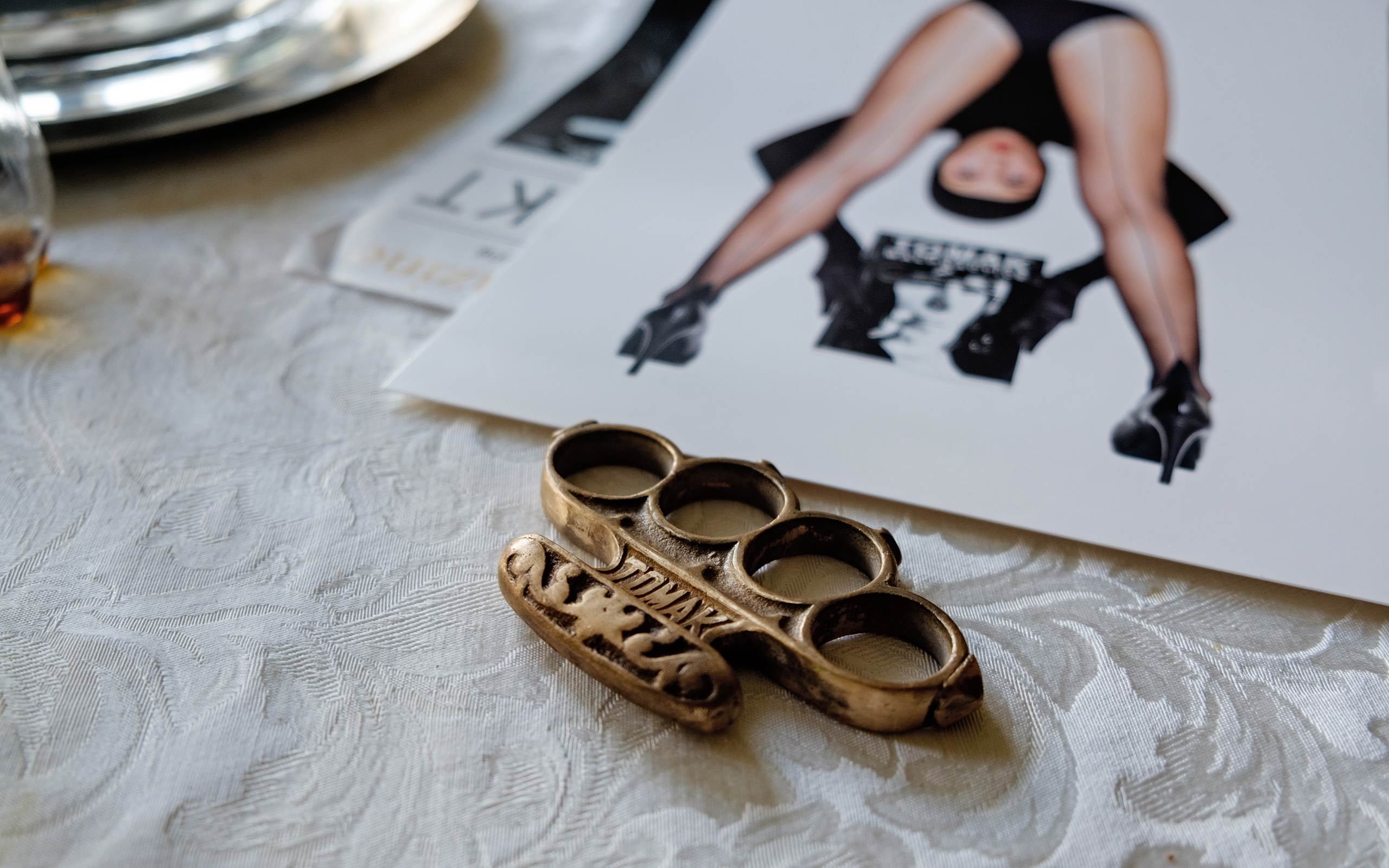
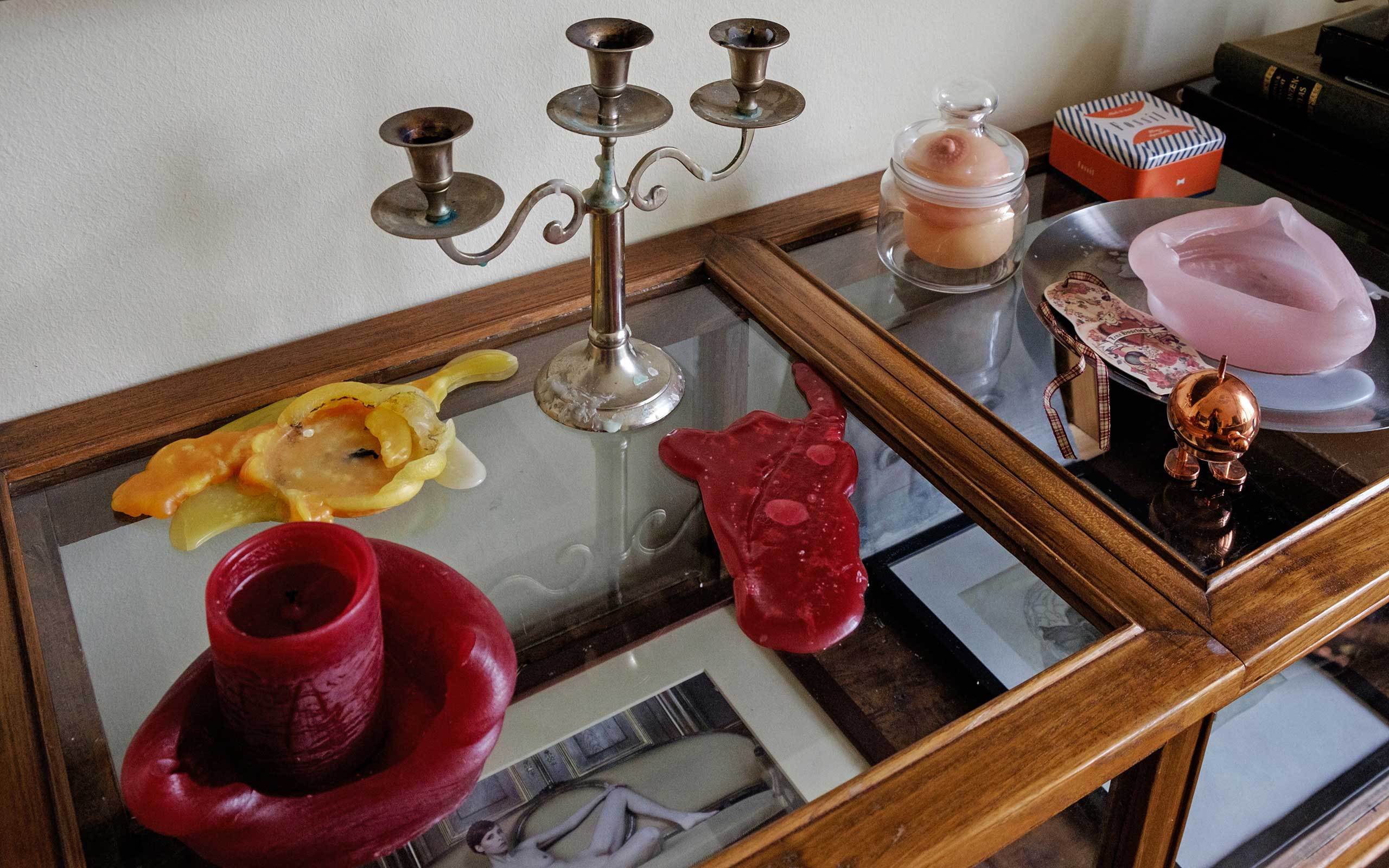
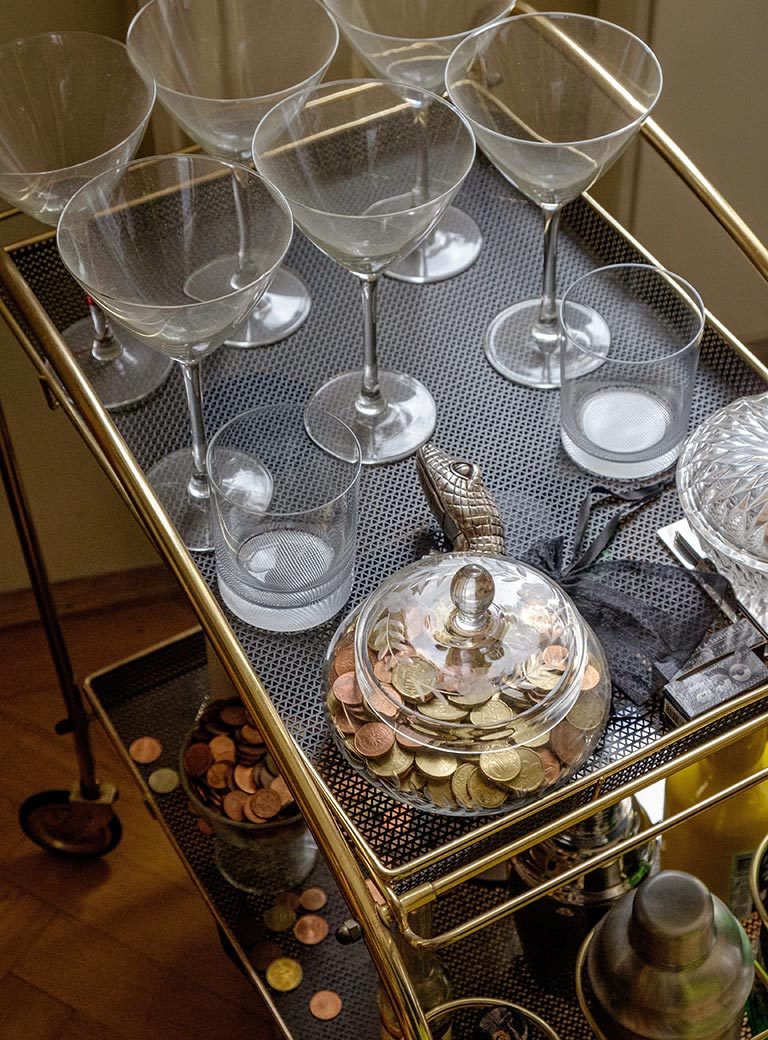
The social responsibility of artists has altered radically in recent years. What does it mean to you to be an artist?
Through ANTIST we are trying to assume the artist’s responsibility again. To be critical of society, be dangerous. I can’t, for example, think of an artist in Austria, who has taken a stand on current issues. And, we have just had elections in Vienna. Years ago things were different. Politicians openly spoke of Alfred Hrdlicka or Friedensreich Hundertwasser as “idiots”. Nobody does that anymore today! Today, many artists are no longer independent. They have enslaved themselves.
Claus Peymann was the last artist to influence people with his art. He always spoke his mind on certain topics. People listened to him because he was employed by the state. As an independent artist you can more or less say what you want. But if you do a large project at the Wiener Festwochen festival like Schlingensief, then you get noticed, and people listen, because it is public money that is “wasted” on it. Then people sit up and listen. That’s how it is in Austria.
In Germany art is discussed in a larger context, the situation is somewhat different. Sadly in Germany, too, discussions about art only take place in the inner circles of the art world itself. But such discussions do still take place! That is no longer so in Austria. The country is simply too small, everybody knows everyone and nobody has the “balls” to say anything.
We need a new generation of artists. The current generation has more or less sold itself with railway station sculptures and – window dressing. It has made them rich, they have become professors and bought their little castles. I don’t see them as artists, just as stupid people. Michelangelo told the pope to fuck off and to stuff his contract. Then when they offered him two more bags of money he caved in! But at least he stood up for himself. We need artists to really speak their minds again. I can afford to do that as my works are already in the large collections of the state museums. You won’t get me knuckling under. We have lost the “Fuck you” attitude of the 1980s.
Do you think the new generation, those that are at the academies now, will alter that?
No, not at all. You can’t expect anything from them. That’s something I have to do (my generation). What we have now is abstraction. Images without any message. Everything’s really banal. You can’t call that art, it is design. And an art fair is no longer an art fair it is also just design. Just because something measures 10 x 10 meters that does not make it art. Just because that idiot Helnwein displays his bloody children that’s supposed to be art? You get that in every horror film. That is the worst rubbish around!
Today, all art aims to do is to shock. Art has other tasks. The content art transports is important. You can shock the man on the street but I’m not interested in that. He sits in his village and is afraid of the minaret. At one time mosques were built to beautify cities. Today, everyone is worried about losing their culture. What culture I ask myself. Gabalier? Jesus Christ?
But there are still institutions in Austria that fascinate you, aren’t there?
Well, yes. Compared with Munich, for example, there are less exciting art venues in Vienna. In Munich, the big international artist are shown. I am happy to travel to Munich for a Matthew Barney exhibition. Afterwards I go to an beer garden and can say I had a fun day. Art is an economic factor that the City of Munich vehemently promotes. You get great exhibitions in Munich.
Of course, Vienna has not much less money than Munich. And sadly politicians do not attempt to create an image through contemporary art. Naturally, there are exceptions in Vienna as regards art institutions. The Kunsthistorisches Museum has woken from its winter sleep and puts on an excellent program. 21er Haus tries to attract people with good exhibitions. But it shares a typical Viennese problem: Everyone thinks it is too far away. However, I think that will alter the more the district around the main station develops.
In Munich there are a number of good people who present art like the Americans do. They just know how to present art in America. I once went to a Schiele exhibition in New York in the MoMA where all the walls were painted black. Nobody here would think of doing that. The paintings looked a thousand times better. And presentations are also done much better in Germany. In Austria there are all these civil servants and they obey the “emperor”. Nobody is willing to assume responsibility. That’s problematic. That’s Austria.
Normal people aren’t given any responsibility in Austria. Which is why they always expect some higher power to deal with it, God, or the emperor. People that are as active as me – and there are a few people who are diligent and active, run from one appointment to the next because they enjoy working. Painting pictures and putting a magazine together are fun. A lot of people are involved in it, illustrators, book printers, binders, galleries, publishers.
»I like the collectors who fetch a different picture from their storehouse every day and enjoy it over a glass of red wine.«
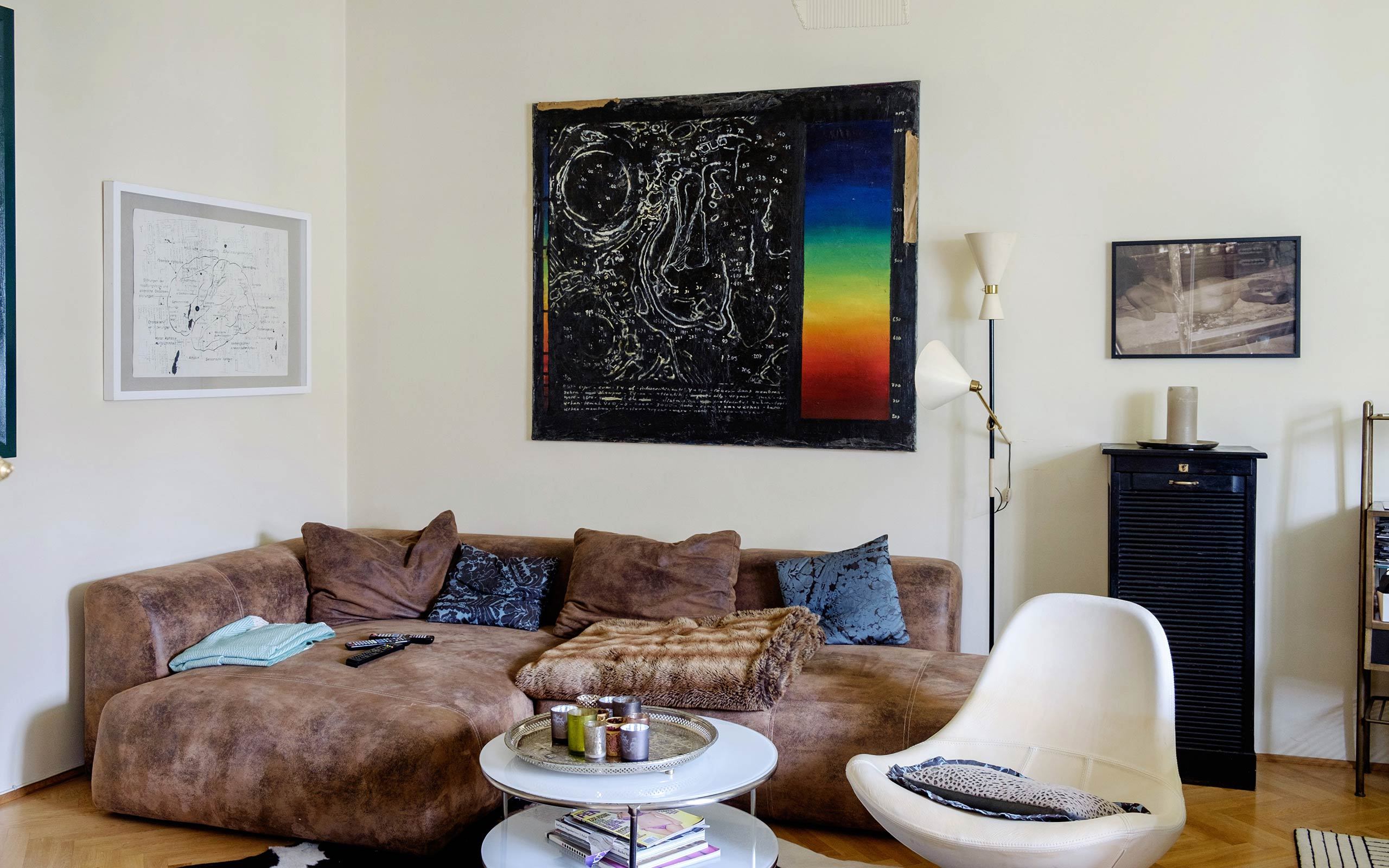
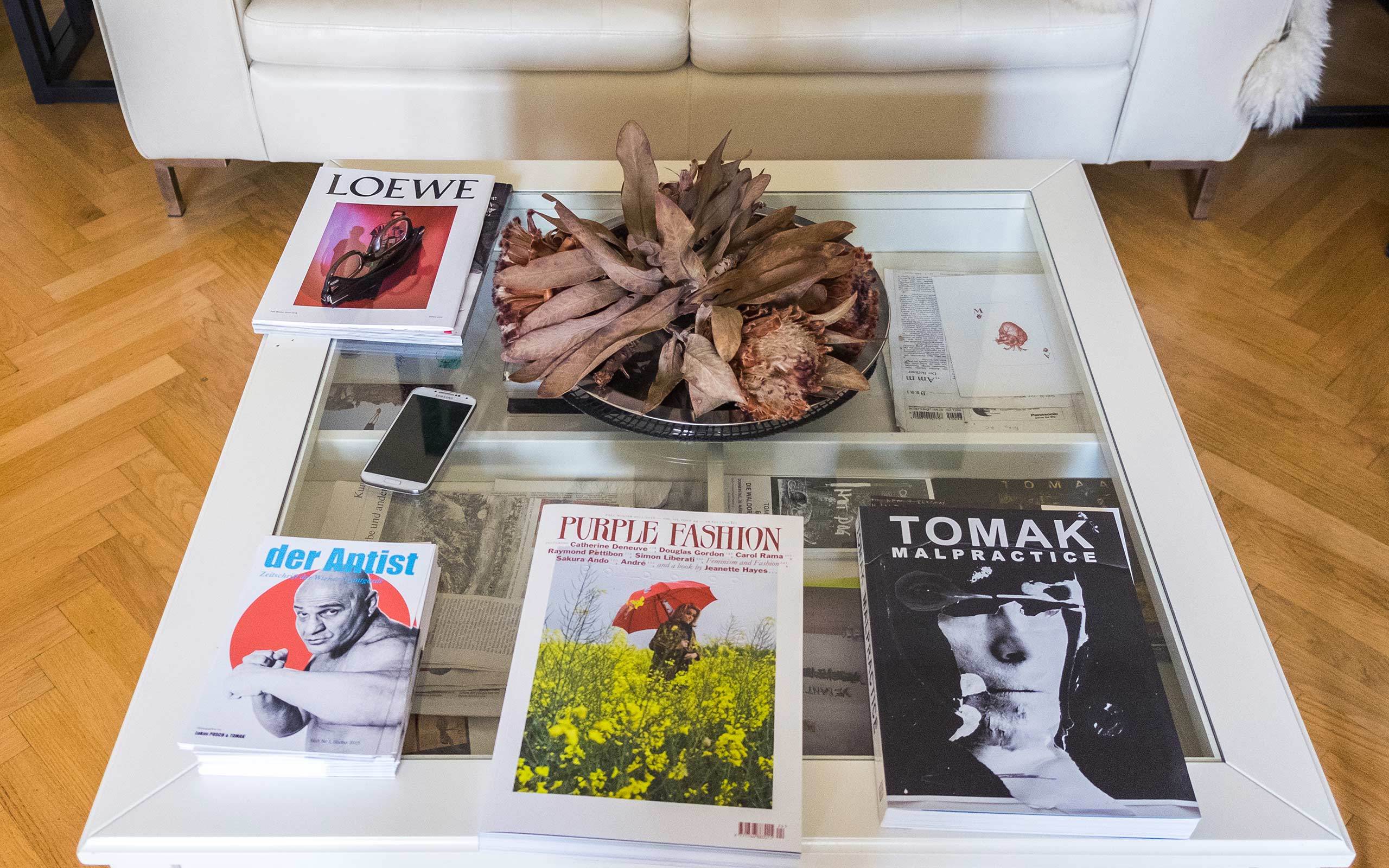
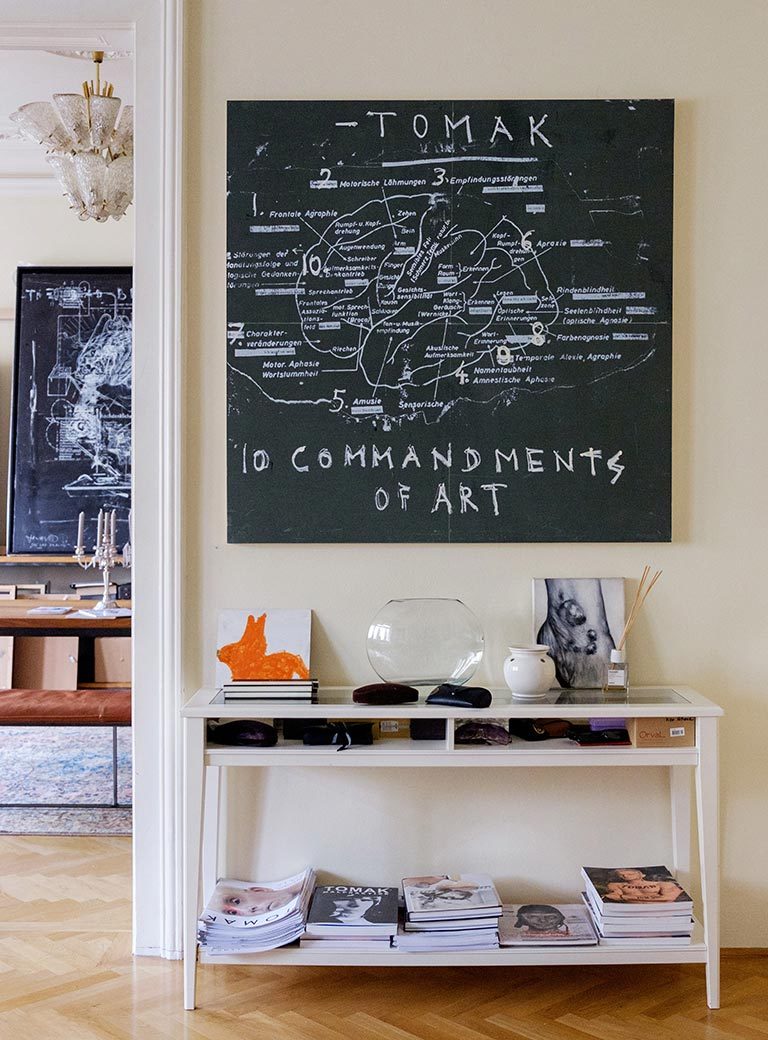
They say you work like crazy. Day and night. Is that true?
Well, someone has to produce the pictures. But today is not a “picture making day”. Today is a different day. You are my fourth appointment today. After this I will finish for the day and drink a beer. But tomorrow I’ll be in the studio again, Sunday, too, and on Monday, and on the public holiday.
And then you work non-stop? What is a “picture making day” like for you? Daniel Richter, for example, says of his days in the studio: “The truth is I sometimes sit around for days listening to records, arranging singles, reading books and paint for seven minutes. I don’t like the act of painting, it is sticky, and you always get dirty fingers.”
So greet Daniel! Then that is what art is like. Good that he reads books. But he ought to read the right ones. Send him one of mine. Read a real book for a change Daniel!
You have just done another comprehensive book after a relatively short time.
I see it as a kind of archive, a way of processing and cataloguing my work. It is for the collectors, who naturally want to see what I have and it works very well as promotion. But it is also good for me. As confirmation of my achievements. Naturally, it is handy for people producing exhibitions to work with and use as reference. That is not possible online in the same way. The attention span online is much too short. But in terms of value for money it is still a better deal than buying an Aston Martin! I am already planning the next book.
Your works consist of several levels. Usually a painterly level, a graphic level and a text level. You must have an enormous archive of old prints.
I collect books, old engravings that I find in antiquarian stores. I have books worth 700 Euro that I then cut up and re-assemble differently. Sometimes it can take a very long time until a picture’s story is right. When somebody buys a TOMAK, it has a certain price tag. However, it is not determined by the art market, but is my own healthy “appreciation”. Simply the price I’m worth.
Text always plays a role in your works. So are there no TOMAK works without text?
There is almost always a headline, yes. Many pictures are composed through the text. A special symbolism develops in my works.
What medium do you paint on? On board or canvas?
I paint on canvases, some of which are put over another canvas. It is all rather complex.
What are you working on right now?
Some time ago I finished working on the presentation at Lisabird in November and have moved on to the next show for Linz. Many people ask me when I manage it all. It’s down to good organization.
Do you organize yourself or does someone else manage your schedule?
Who else should organize me? I had assistants. But they couldn’t keep up with my speed.
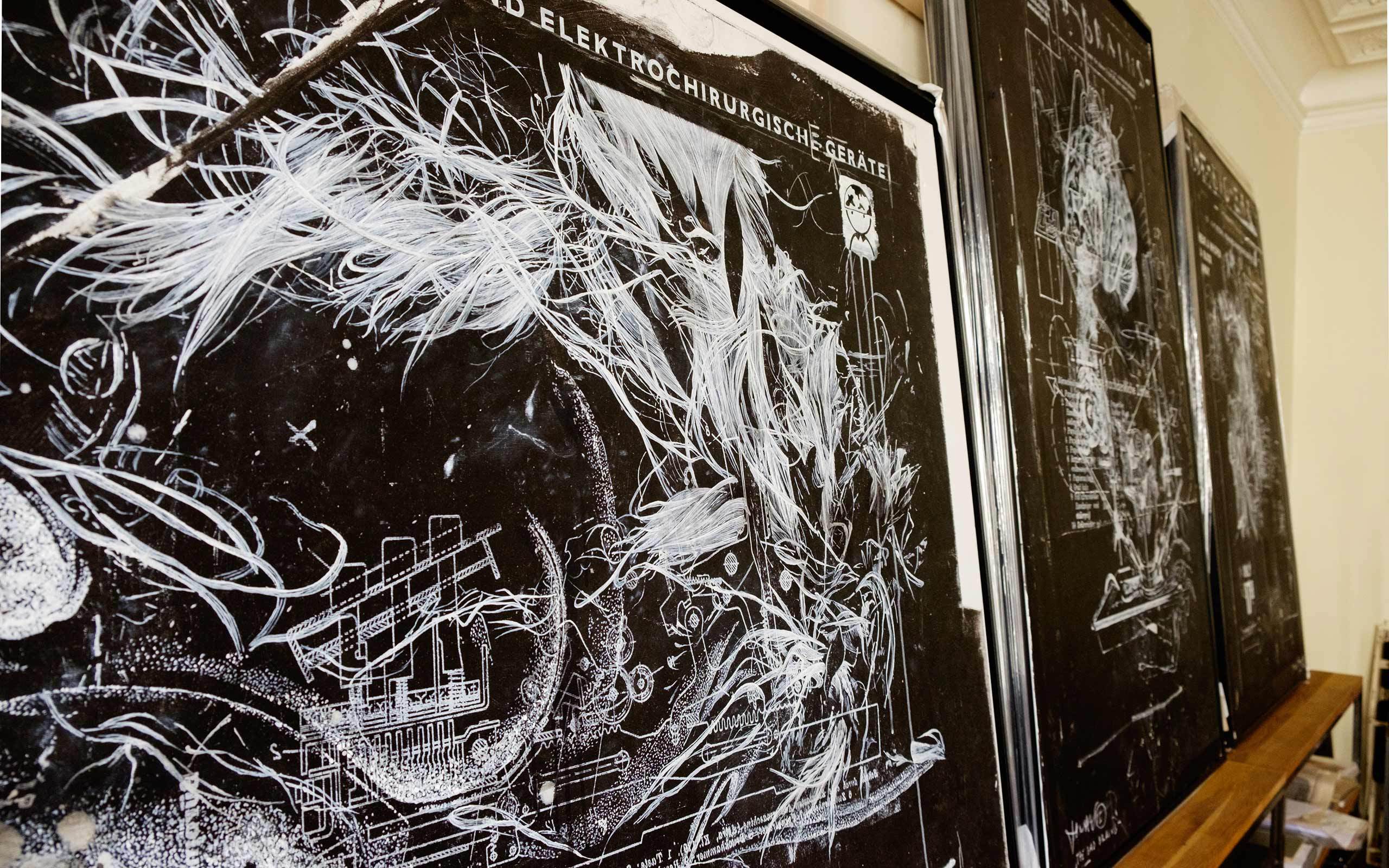
Do you collect art?
No. I tend to collect small objects for my display case. I’m saving up for an Aston Martin so I can’t afford to buy art. Sometimes I get given art. Then I put it in my cubby-hole.
That’s a bit like Damien Hirst who is delighted to have a Francis Bacon in the toilet.
That is marketing. He is a brand himself. Sadly his art has become rather flat. He had a good year. His first year. He was still aggressive then. He was new and good. But he has not developed. When you are a brand, everybody wants something by you. So what happens? You get flat! I don’t do that Everyone wants drawings by me, but I don’t do any!
I have done enough drawings! I get 7,000 Euro for a drawing, for a painting I get 30,000 Euro! And it’s more fun working on a large surface. Drawing is very tiring.
So what’s next, what’s the next project?
The exhibition in Joanneum Das gezeichnete Ich (The marked Self) has just ended in which 20 of my paintings were shown. In spring I am at the up-and-coming fair in Dallas, Texas with Lisabird. Before that I have an exhibition in Linz. I am very “hot” just now
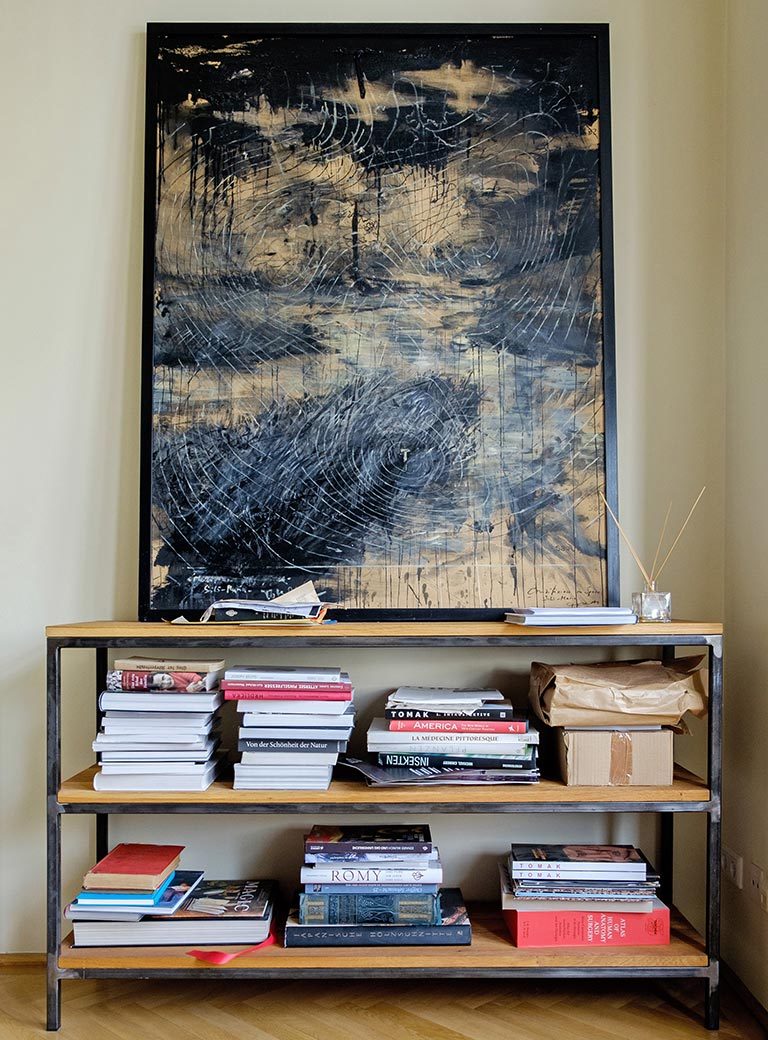
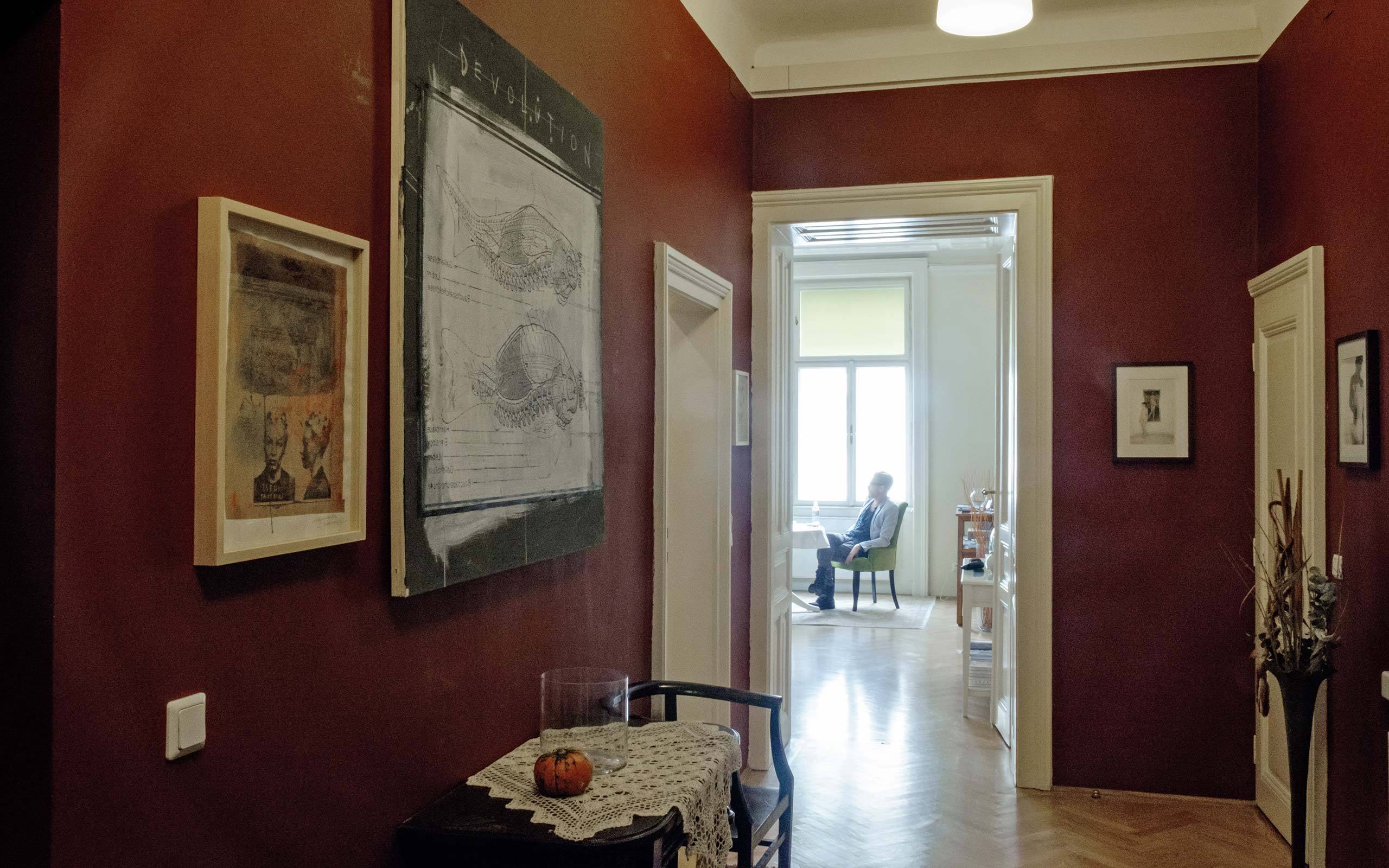
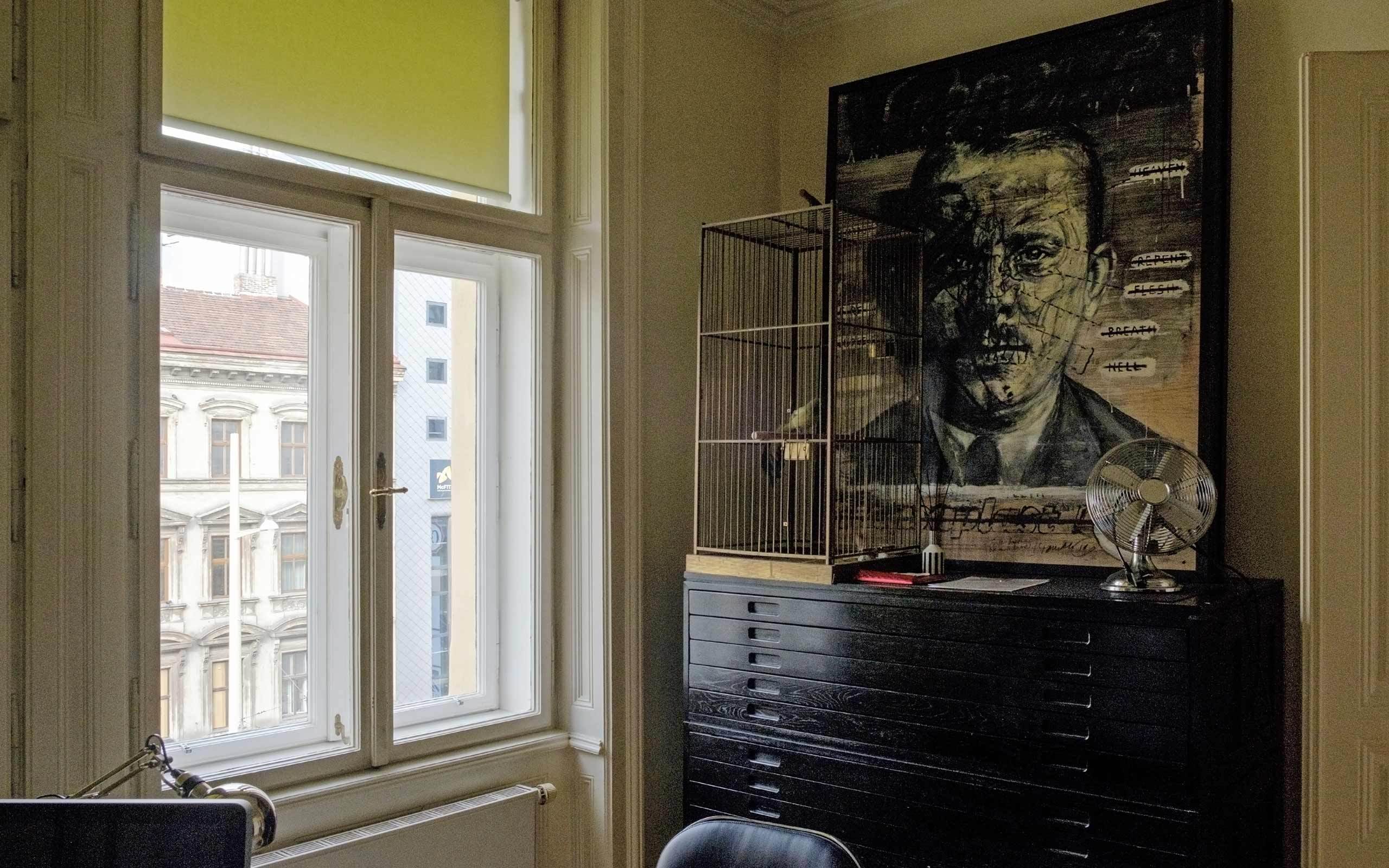
Interview: Michael Wuerges
Photos: Maximilian Pramatarov


